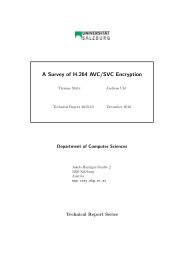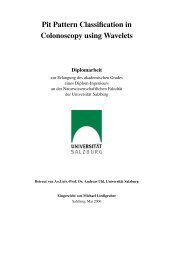Single-sensor hand and footprint-based multimodal biometric ...
Single-sensor hand and footprint-based multimodal biometric ...
Single-sensor hand and footprint-based multimodal biometric ...
Create successful ePaper yourself
Turn your PDF publications into a flip-book with our unique Google optimized e-Paper software.
2.3 System performance<br />
Modality Universality Distinctiveness Permanence Collectability Performance Acceptability Circumvention<br />
H<strong>and</strong> geometry medium medium medium high medium medium medium<br />
Palmprint medium high high medium high medium medium<br />
Fingerprint medium high high medium high medium medium<br />
Soleprint medium medium medium low medium medium medium<br />
Foot geometry medium medium medium low low medium medium<br />
Ballprint low high medium low medium medium medium<br />
Table 2.1: Comparison of <strong>h<strong>and</strong></strong>-<strong>based</strong> (in: Jain et al. [14]) <strong>and</strong> <strong>footprint</strong>-<strong>based</strong> <strong>biometric</strong><br />
technologies (according to the author’s perception).<br />
In the early stages of <strong>biometric</strong> research these properties characterised existing systems<br />
very well. Today, due to the diversity of existing algorithms, they can rarely be used to<br />
predict or classify the performance of a specific system. Using common fusion techniques<br />
it is possible to incorporate multiple matchers into a single <strong>biometric</strong> system yielding<br />
higher performance than each of the single <strong>biometric</strong>s [32]. Furthermore, techniques like<br />
cancelable <strong>biometric</strong>s influence acceptability.<br />
2.3 System performance<br />
Concrete <strong>biometric</strong> systems are assessed using statistical error analysis. There are a number<br />
of errors made by <strong>biometric</strong> systems, which need to be understood <strong>and</strong> estimated<br />
before a particular <strong>biometric</strong> is selected for application. Since various error types depend<br />
on the formulation of hypotheses, I clearly state the examination of positive authentication<br />
in both verification <strong>and</strong> identification mode.<br />
A verification system has to classify the input X into one of two classes, i.e. given a claimed<br />
(enroled) identity M it decides which of the following (null <strong>and</strong> alternate) hypotheses is<br />
true [21]:<br />
H0 : X ≡ M, i.e. both templates refer to the same person; (2.1)<br />
Ha : X �≡ M, i.e. the templates do not refer to the same person. (2.2)<br />
Consequently there are two errors this type of a verification system can make [1], namely<br />
false accepts <strong>and</strong> false rejects.<br />
Definition 2.3.1 (False Accept). False accepts refer to deciding H0 is true, while in reality<br />
Ha is true (an imposter is accepted by the system). The relative frequency of this error is<br />
called False Accept Rate (FAR).<br />
11








